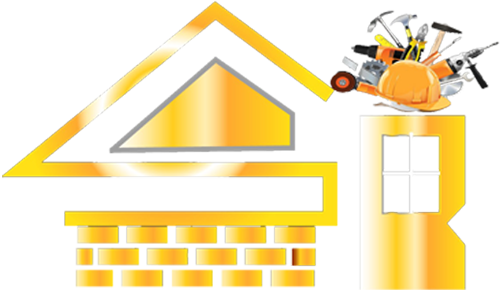You may have seen modified bitumen roofing on commercial or residential structures with flat or low-slope roofs. This durable, cost-effective roofing system has been the go-to solution for protecting buildings from the elements for decades.
But what exactly is modified bitumen roofing, and why is it so important?
In simple terms, modified bitumen is an upgraded form of traditional asphalt roofing, designed to offer better flexibility, durability, and weather resistance. It’s a material that’s been modified with synthetic polymers to withstand extreme temperatures, UV radiation, and moisture, which makes it perfect for flat roofs that face constant exposure.
In this blog post, we will break down everything you need to know about modified bitumen roofing. From its origins to the types of membranes used and the 5-layer system that makes it so reliable, we’ll cover it all. Additionally, we’ll explore the pros and cons, installation methods, and even how to repair this type of roofing. By the end of this post, you’ll understand why modified bitumen is a top choice for flat roofs and how it can offer long-lasting protection for your home or business.
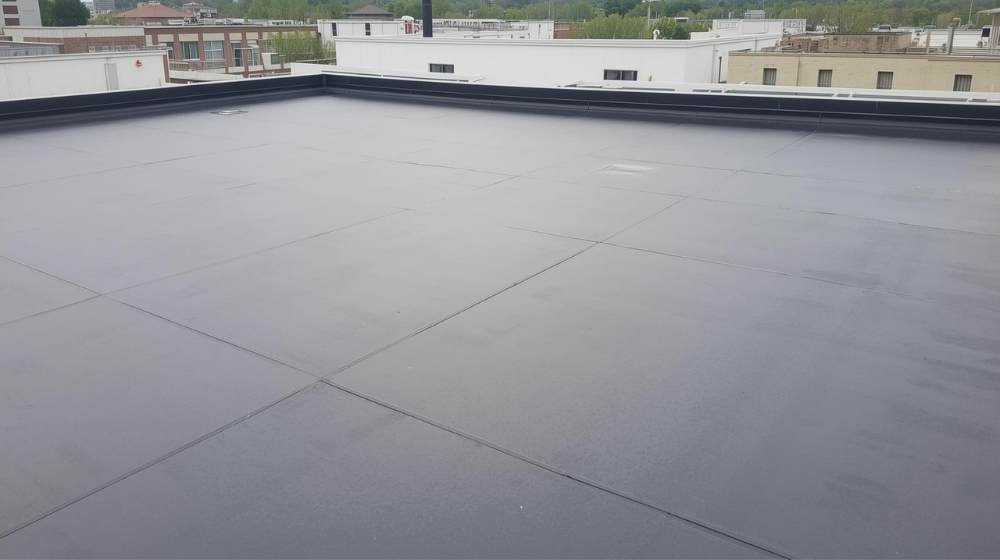
Key Information
- Built for flat and low-slope roofs on homes and commercial buildings.
- Modified asphalt with polymers delivers better flexibility, durability, and weather resistance.
- Typical service life ranges from 15 to 30 years, based on climate and maintenance.
- System components: bitumen, APP/SBS polymers, reinforcement, mineral granules, adhesives, UV coating.
- Originated in the 1960s in Europe; reached North America in the 1970s; remains popular.
- Membrane types: APP, SBS, self-adhered, torch-down, and cold-applied options are available.
- Five-layer build: base, reinforcement, modified bitumen, protective layer, granulated or reflective cap.
- Key advantages include durability, waterproofing, flexibility, low maintenance, energy savings, and improved fire performance.
- Main drawbacks include higher upfront costs, installation complexity, puncture risk, and environmental and aesthetic limitations.
- Brooklyn costs about $10.95–$24.30 per square foot, driven by the cost of materials and insulation.
What Is Modified Bitumen Roofing?
Modified bitumen roofing is a durable, waterproof material made from bitumen combined with polymers. It is designed to improve the performance of traditional asphalt by making it more flexible and resistant to extreme temperatures. This roofing system is often used on flat and low-slope roofs. It offers long-lasting protection against weather damage. Its features include strength, durability, and ease of maintenance, which make it a popular choice for both commercial and residential buildings.
What Materials and Components Are Used for Modified Bitumen Roofing?
Modified bitumen roofing uses a combination of materials to create a durable and effective roofing system. Each component works together to enhance the roof’s ability to withstand various weather conditions.
1. Bitumen: Bitumen is the core component of the material. It is a thick, tar-like substance that provides excellent waterproofing properties.
2. Polymers (APP and SBS): Polymers like APP (Atactic Polypropylene) and SBS (Styrene-Butadiene-Styrene) are added to modify the bitumen. These increase the material’s flexibility and resistance to temperature extremes.
3. Reinforcing Fabrics (Fiberglass or Polyester): Reinforcing fabrics such as fiberglass or polyester are embedded in the layers. They provide added strength and prevent cracking and damage.
4. Mineral Granules: Mineral granules cover the top layer. They protect the roof from UV rays and provide a textured, finished look.
5. Adhesives: Adhesives bond the layers of the roofing system together. They ensure the layers stay securely in place over time.
6. UV Protection Coating: A UV protection coating is applied to prevent sun damage. This coating extends the roof’s life by protecting it from harsh sunlight.
The Origins of Modified Bitumen Roofing
Modified bitumen roofing originated in Europe in the 1960s as a means to enhance traditional asphalt roofing. The addition of synthetic polymers helped create a more flexible, durable material. This innovation enabled the roofing to perform more effectively in diverse climates and weather conditions. In the 1970s, modified bitumen roofing gained popularity in North America, where it was adopted for both residential and commercial applications. Today, it remains a trusted choice for roofing due to its performance, longevity, and cost-effectiveness.
Types of Modified Bitumen Roofing Membrane
Modified bitumen roofing comes in various types, each designed to meet specific needs and conditions. These membranes are primarily categorized by the type of modifier used and the method of application. The key types offer different benefits, making it easier to choose the best option for your roof. Let’s explore the five main types of modified bitumen membranes.
1. APP (Atactic Polypropylene) Modified Bitumen
APP-modified bitumen is made by adding polypropylene to the bitumen. This type of membrane is known for its excellent heat resistance and UV stability.
- Materials: Polypropylene, bitumen, fiberglass, or polyester reinforcement.
- Features:
- UV resistant
- Strong heat tolerance
- Durable under harsh weather conditions
- Available in various colors
- Advantages:
- Long lifespan
- Minimal maintenance
- Suitable for hot climates
- Superior resistance to aging
- Ideal for: Commercial and industrial roofs with high sun exposure.
2. SBS (Styrene-Butadiene-Styrene) Modified Bitumen
SBS-modified bitumen is enhanced with a rubber-like polymer. It is known for its flexibility and ability to withstand cold temperatures.
- Materials: Styrene-Butadiene-Styrene polymer, bitumen, fiberglass, or polyester reinforcement.
- Features:
- Excellent flexibility
- Cold weather resistance
- Superior adhesion to surfaces
- Elastic properties
- Advantages:
- Ideal for areas with fluctuating temperatures
- Good impact resistance
- Easy to repair
- Longer lifespan in colder climates
- Ideal for: Residential and commercial buildings in colder climates.
3. Self-Adhering Modified Bitumen
Self-adhering membranes use an adhesive backing, which eliminates the need for hot asphalt or torches during installation. It offers a straightforward and secure installation process.
- Materials: Modified bitumen, adhesive backing, protective release film.
- Features:
- No need for torches or heat
- Simple application
- Quick installation
- Lower risk of installation errors
- Advantages:
- Safer installation
- Energy-efficient
- Provides an airtight seal
- Less labor-intensive
- Ideal for: DIY roofers or projects with safety concerns.
4. Torch-Down Modified Bitumen
Torch-down membranes are installed using a propane torch that melts the bitumen as it is applied to the roof. This method creates a strong bond.
- Materials: Bitumen, polyester or fiberglass, mineral granules.
- Features:
- Strong bonding with the roof
- Heat application for a seamless installation
- Long-lasting
- Waterproof finish
- Advantages:
- Ideal for low-slope roofs
- Excellent waterproofing
- Highly durable
- Resistance to high winds
- Ideal for: Large commercial roofs with low slopes.
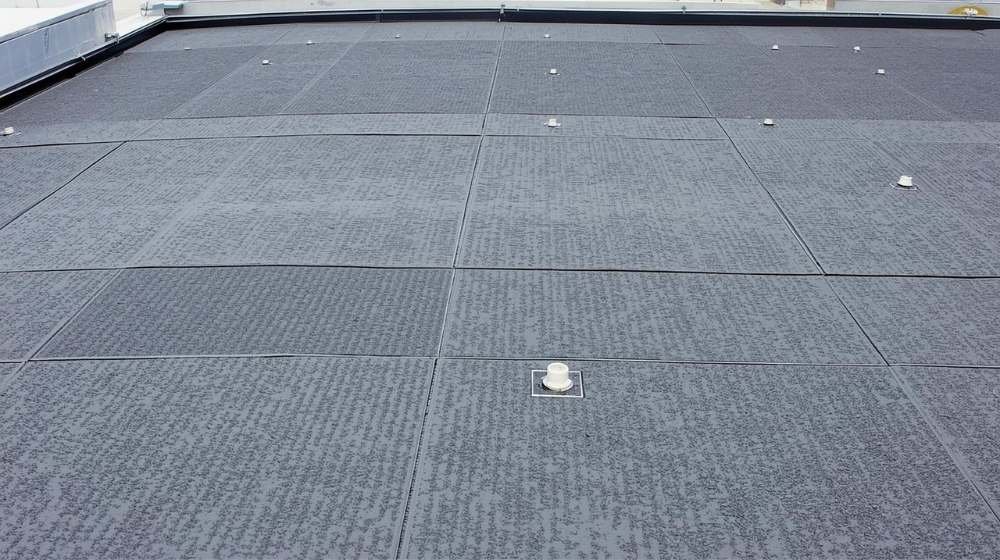
5. Cold-Applied Modified Bitumen
Cold-applied modified bitumen membranes are installed without heat, utilizing adhesives or other cold-bonding agents.
- Materials: Bitumen, polymer modifier, adhesive, or bonding agent
- Features:
- No heat required
- Safe for all weather conditions
- Easy to apply
- Provides a durable finish
- Advantages:
- Quick application
- Safe for the environment
- Ideal for sensitive areas
- Cost-effective installation
- Ideal for: Smaller residential projects or roofs with safety restrictions.
Modified Bitumen Roofing’s 5-Layer System
Modified bitumen roofing systems are recognized for their robust five-layer construction, which offers superior protection and durability. Each layer serves a unique purpose, contributing to the overall strength and longevity of the roof. Here’s a breakdown of the five essential layers:
- Base Layer: The first layer is applied directly to the roof deck. It provides a solid foundation for all subsequent layers. The base layer acts as a protective barrier and adds stability.
- Reinforcement Layer: This layer, made from fiberglass or polyester, is embedded within the base layer. It adds strength and helps prevent tears or cracking in the roof membrane.
- Modified Bitumen Layer: This layer consists of modified bitumen, which provides waterproofing and flexibility. It is the primary barrier against water infiltration and extreme weather.
- Protective Layer: A protective layer is added on top to shield the bitumen from UV rays and physical damage. This layer ensures the roof maintains its structural integrity and resists degradation from sunlight.
- Top Layer: The top layer is usually made from mineral granules or other materials.
It provides UV protection and enhances the roof’s appearance, which helps reflect heat and reduce energy costs.
What Makes Bitumen Roofing Special?
Modified bitumen roofing stands out for its ability to combine the strength of traditional asphalt with enhanced flexibility and resistance to harsh weather. Its multi-layer system creates a durable, waterproof barrier, which makes it ideal for flat and low-slope roofs. Modified bitumen materials are designed to resist temperature changes and UV degradation for long-lasting protection. This roofing system offers great versatility, which allows for easy installation and minimal maintenance over the years.
Pros and Cons of Modified Bitumen Roofing
Before choosing modified bitumen roofing for your structure, it is essential to consider its benefits and limitations. It helps you evaluate its long-term benefits and potential drawbacks. Being informed allows you to make the best decision based on your specific needs and roof conditions.
Advantages of Modified Bitumen Roofing
- Durability: Modified bitumen roofing is known for its exceptional durability. It can resist different weather conditions like heavy rains, high winds, and extreme temperatures. With proper maintenance, it can last up to 20 years or more, which provides a long-term solution.
- Waterproofing: One of the main advantages of modified bitumen roofing is its superior waterproofing capabilities. The material forms a solid, impermeable barrier that prevents water from infiltrating the building. This waterproof quality helps protect the structure and interior from water damage.
- Flexibility: Modified bitumen roofs are designed to be flexible, even in cold weather. This flexibility helps prevent cracks and leaks, especially in areas with fluctuating temperatures. It ensures the roof adapts to temperature changes without compromising its integrity.
- Low Maintenance: Once installed, modified bitumen roofs require very little maintenance. The materials are resistant to damage, and the multi-layer system prevents common issues like leaks or cracks. This reduces long-term repair costs and effort.
- Energy Efficiency: The reflective surface of modified bitumen roofs can help reduce heat absorption. This feature lowers the building’s cooling costs, especially in hot climates. It also helps maintain a more stable indoor temperature throughout the year.
- Fire Resistance: Modified bitumen roofing offers good fire resistance. The materials used are designed to tolerate high temperatures. This feature reduces the risk of fire damage. This is particularly important for buildings in areas prone to wildfires or extreme heat.
- Ease of Installation: Modified bitumen roofs are relatively easy to install compared to other roofing systems. The process is straightforward, especially for systems that use self-adhering membranes. This can result in faster installation times and lower labor costs.

Disadvantages of Modified Bitumen Roofing
- Initial Cost: The initial cost of installing modified bitumen roofing may be higher than that of traditional roofing options. This is due to the quality of materials used and the complexity of the installation process. However, the material’s long lifespan helps offset this upfront cost.
- Installation Complexity: While installation is generally straightforward, it can still be complex and requires professional expertise. The need for heat application in certain installation methods (like torch-down) can increase the risk of mistakes. Incorrect installation may result in leaks or reduced roof life.
- Vulnerability to Punctures: Modified bitumen roofing can be vulnerable to punctures or damage from sharp objects. While it is durable against weather conditions, certain activities on the roof or harsh conditions can cause physical damage. Proper care during maintenance is crucial to avoid this issue.
- Environmental Impact: While modified bitumen roofs are durable, the materials used may not be entirely environmentally friendly. The production of bitumen and the use of synthetic polymers can have a negative environmental impact. Recycling options for modified bitumen materials are limited.
- Aesthetic Limitations: Modified bitumen roofs are functional but may not offer the same aesthetic appeal as other roofing materials. While they can be covered with granules for a finished look, they may not be as visually appealing as materials like shingles or tiles. This may be a concern for those who prioritize aesthetics in residential roofing.
Expert’s Guide: Factors to Consider Before Installing Modified Bitumen Roof Systems
- Roof slope and structure suitability
- Climate and weather conditions in your area
- Roof traffic and maintenance needs
- Budget for installation and long-term costs
- Local building codes and regulations
Installation Method of Modified Bitumen Roof Systems
Modified bitumen roof installation involves several methods, each with its own advantages. The installation process must be done correctly to ensure the roof’s effectiveness and longevity. Here’s a breakdown of the main installation methods:
- Torch-Down Installation: In this method, a propane torch is used to melt the bitumen and adhere it to the roof surface. It creates a strong bond and is effective for low-slope roofs. This method requires professional expertise to avoid risks associated with heat.
- Self-Adhering Membrane Installation: Self-adhering membranes come with an adhesive layer that bonds directly to the roof. This installation method is easier and safer since no heat or torches are required. It’s ideal for DIY projects or roofs with safety concerns.
- Cold-Applied Installation: Cold-applied methods use adhesives instead of heat. This is a safer and more environmentally friendly option. The installation process is slower, but it can be ideal for areas where fire safety is a priority.
- Hot Asphalt Installation: Hot asphalt is used to install modified bitumen roofing. It creates a strong bond between layers. This method is more traditional and is often used for large commercial roofs. It requires special equipment and skilled labor to avoid mistakes.
- Mechanically Attached Systems: Mechanically attached modified bitumen is fastened using screws or plates, which secure the roofing to the deck. This method is quicker than others and offers excellent wind resistance. It is a good choice for areas prone to high winds.
- Fully Adhered System: The fully adhered system involves bonding the modified bitumen directly to the roof using adhesive. This method provides a seamless, watertight seal. It’s highly effective for preventing leaks and ensuring long-term roof stability.
Modified Bitumen Roof Repairing Process
A small leak can grow fast. A simple plan protects the roof and the space below. Here are clear steps you can follow.
- Inspect and map the problem: Walk the roof after a rainstorm or conduct a hose test. Mark blisters, open seams, soft spots, and punctures. Note where water may travel from a higher point to the leak spot.
- Clean and dry the area: Sweep off dust and loose granules. Remove dirt and old mastics in the repair zone. Dry the surface thoroughly so that primers and patches can bond effectively.
- Cut and remove defects: For blisters, slice an “X,” fold back flaps, and cut out wet felt. Feather rough edges and discard saturated pieces. Create a sound, dry base before applying any patch.
- Prime and reinforce: Apply the manufacturer’s primer where required. Set a reinforcing ply (polyester or fiberglass) in hot asphalt, cold adhesive, or heat‑weld where the system allows. The goal is a flat, fully bonded seat for the cap patch.
- Patch and seal: Install a compatible mod‑bit patch that covers the repair with at least 3–6 inches of overlap on all sides. Use the correct method for the system: torch, cold-applied, or self-adhered. Roll the patch tight and seal the edges.
- Finish and verify: Embed matching granules into the hot surface or coat smooth patches for UV protection. Check the seams after cool-down and perform a water test. Log the repair date and location for future checks.
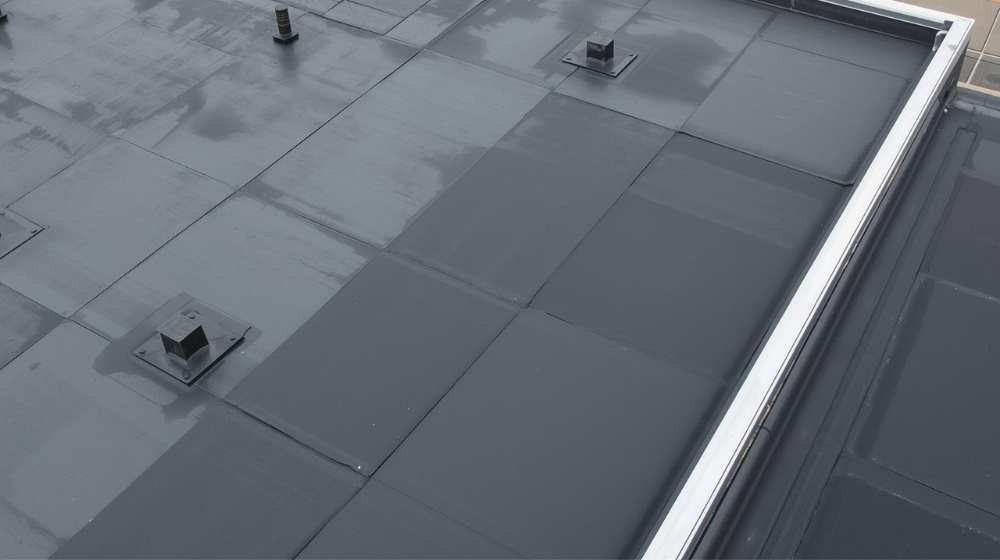
How Much Does a Modified Bitumen Roof Installation Cost (per sq. ft.) in Brooklyn, NYC?
Brooklyn is situated within the NYC metro area, which has some of the highest construction costs in the state. The totals below reflect 2025 New York averages per square foot for modified bitumen systems. Brooklyn bids often fall at the high end of these ranges due to local labor rates and operating costs.
| Modified Bitumen Roof Type (NY avg) | Material Cost ($/sf) | Labor Cost ($/sf) | Total Cost ($/sf) |
| APP, 2‑ply, no new insulation | 4.38 | 6.57 | 10.95 |
| SBS, 2‑ply, no new insulation | 4.64 | 6.96 | 11.60 |
| APP, 2‑ply, with R‑30 insulation | 8.04 | 12.06 | 20.10 |
| SBS, 2‑ply, with R‑30 insulation | 8.28 | 12.42 | 20.70 |
| APP, 3‑ply, with R‑30 insulation | 9.36 | 14.04 | 23.40 |
| SBS, 3‑ply, with R‑30 insulation | 9.72 | 14.58 | 24.30 |
Pro Tip
Request a line-item bid that breaks down materials, labor, tear-off, and insulation costs to help control expenses in Brooklyn.
Modified Bitumen vs. Other Roofing Types
It’s easier to compare key criteria when selecting a roof. The table below summarizes the performance and cost of common systems used in NYC buildings.
| Roofing Type | Durability (typical) | Waterproofing approach | Maintenance | Install difficulty | NY typical cost ($/sf) |
| Modified Bitumen (APP/SBS) | Long life with 2–3 plies; tough against foot traffic | Redundant plies with fused seams | Low to moderate | Moderate to high, needs trained crew | $10.95–$24.30 |
| EPDM (single‑ply) | Good UV resistance; puncture risk under heavy traffic | Adhesive or taped seams | Low; watch seams and penetrations | Moderate | $6.70 (no insulation) / $17.45 (R‑30) |
| TPO (single‑ply) | Good in heat; reflective | Hot‑air welded seams | Low; check welds | Moderate to high | $6.40 (no insulation) / $17.15 (R‑30) |
| PVC (single‑ply) | Strong chemical resistance; welded seams | Hot‑air welded seams | Low; check welds | Moderate to high | $7.35 (no insulation) / $18.00 (R‑30) |
| Built‑Up Roofing (BUR) | Durable multi‑ply asphalt; heavy | Multiple felts in asphalt with surfacing | Low; watch ballast/gravel | High; hot work and weight | $7.78–$9.66 (national baseline; NYC often higher) |
| Standing‑Seam Metal | Very long life; excellent wind/snow shed | Interlocking metal panels | Low; inspect fasteners/flashing | High; skilled metalwork | $15–$19+ (NY examples) |
| Asphalt Shingles (for pitched roofs, not flat) | 20–40 years by product class | Overlapping courses with underlayment | Low; periodic checks | Moderate | $6.70–$9.20 (NY) |
What Is Commercial Modified Bitumen Roofing?
Commercial modified bitumen roofing is an asphalt membrane enhanced with polymers, such as SBS or APP, for added flexibility and toughness. It is built for low-slope roofs and uses multi-ply layers that form a primary waterproof surface. Crews install it by heat welding, hot asphalt, cold adhesive, or self-adhering methods. These features make it a strong fit for busy, foot-trafficked commercial roofs.
What Is Modified Bitumen Roof Coating, and How Does It Work?
An existing mod-bit roof is coated with liquid to offer UV protection, reflect heat, and seal minor surface damage. Common chemistries include acrylic and silicone, which cure into seamless, elastic films. On asphaltic roofs, acrylic systems can turn dark mineral caps “white” to cut heat, while silicone systems can restore smooth modified bitumen and improve waterproofing. Proper maintenance, repairs, and coverage are key to long service.
How Does the Torch-Down Modified Bitumen Roof System Work?
Torch-down uses controlled heat to fuse sheets into a continuous membrane. Here is the flow in simple steps:
- Prepare deck, insulation, and base sheet.
- Align the cap sheet and set the correct side-lap and end-lap.
- Heat the underside film until bitumen flows and forms a bleed line.
- Roll the sheet in with a weighted roller for full bond.
- Heat-weld seams and details for a monolithic seal.
- Check laps and add surfacing where required.
How Long Does a Modified Bitumen Roof Last?
A well-installed modified bitumen roof often lasts 15 to 30 years. Climate, foot traffic, and drainage affect the result. Regular inspection and timely repairs help reach the upper end of that range.
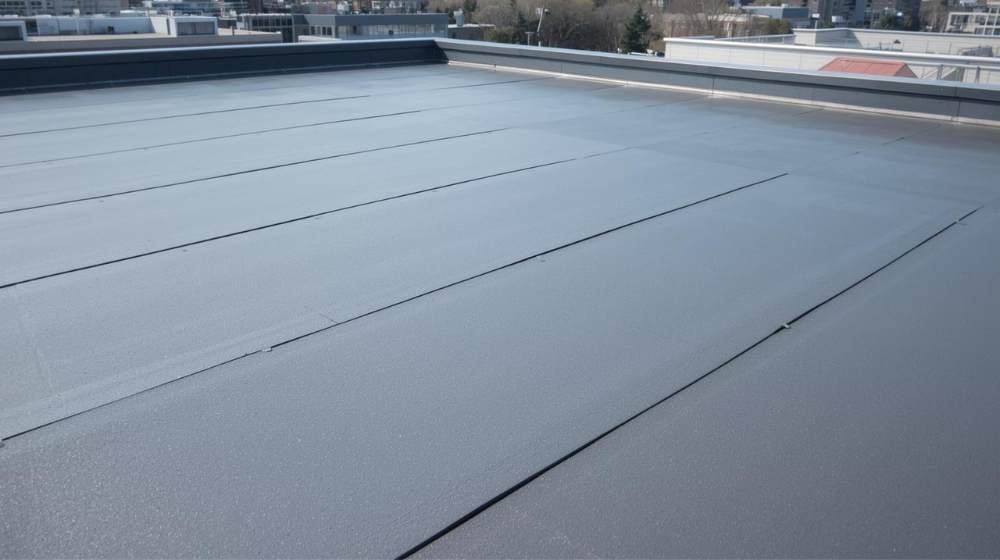
Why should you choose a professional roofing contractor?
Are you looking for an expert roofing contractor in Brooklyn, NYC? SR General Construction has you covered! Our business is located at 8807 Avenue B, Brooklyn, NY 11236, United States, in the Canarsie area.
We proudly serve all areas of Brooklyn with high-quality, durable roofing solutions. From new installations to repairs and maintenance, we provide the best service at affordable prices. Contact us and experience why we’re Brooklyn’s roofing experts!
FAQ
1. What is modified bitumen roofing?
Modified bitumen is an asphalt roof membrane that utilizes polymers (APP or SBS) to enhance its flexibility and durability. It is built for flat and low-slope roofs on homes and commercial buildings.
2. How long does a modified bitumen roof last?
Typical service life is about 15–30 years, based on climate, installation quality, and care. Some certified systems show service lives beyond 30 years.
3. Which is better: APP or SBS?
APP handles heat and UV very well, making it suitable for hot, sunny regions. SBS stays flexible in cold weather and tolerates movement.
4. Do I need 2-ply or 3-ply?
Both are used; more plies add redundancy. Independent cost data notes that 3-ply systems often last longer than 2-ply under similar conditions.
5. What roof slope is required?
Code and NRCA guidance recommend a minimum slope of 1/4 inch per foot (2%) for modified bitumen. Design the roof to drain to outlets without standing water.
6. How much does it cost per square foot?
Recent guides indicate a range of $8–$21 per square foot, depending on the number of plies and insulation. Some consumer estimates for basic projects range from $4 to $7.50 per square foot.
